The following article is written by MW Team Writer:
Hayward Gladwin
The Secret and Sacred Geometry of Leonardo da Vinci’s The Last Supper
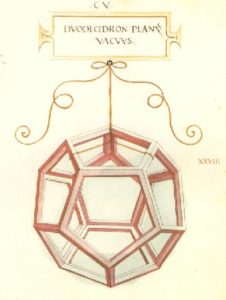
For the era of its making, Leonardo Da Vinci’s “The Last Supper” was a triumph of art historical proportions. The work incorporated features of perspective, narrative and visual motion at a level perhaps not achieved elsewhere to such a degree at any time prior. Commissioned by Ludovico Sforza (The Duke of Milan) in 1494, the work is housed where it was originally painted– at the monastery of Santa Maria delle Grazie in Milan, Italy. It is a painting which has long since challenged viewers, partly in recognition of Leonardo’s baffling painterly skill, but also with respect to the subject matter being depicted both at its surface and that “encrypted” beneath it.
Several theories surrounding the alleged truth about this enigmatic painting have emerged over the years. Some have propositioned that the painting shows the controversial figure of Mary Magdalena being positioned next to Christ at the table. Some have described how the gestures of the Apostles seemingly represent hand gestures which are secretly found in Masonic rituals. Others have spoken about the symbolism of the 12 stations of the Zodiac and the Sun being represented by Christ and his surrounding 12 apostles. Yet, as curious these theories might be, there is perhaps another level to the work which could be of deep interest; that being the structure of the work’s visual composition and its relationship to Sacred Geometry.
For The Last Supper, Leonardo used a ‘one point perspective’, a composition device of pictorial design which at his time was relatively new, as its first examples are found just a little bit earlier in the Renaissance. A prime example would be Masolino’s ‘St. Peter Healing a Cripple and the Raising of Tabitha’ from 1425. In such a work, the viewer can readily recognize how the orientation of the edges of the building structures conform to a series of lines with a common point of reference.
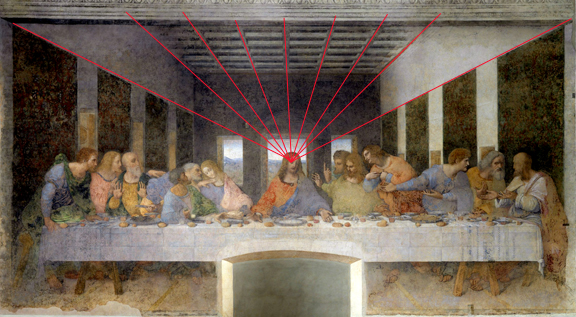
In the case of Leonardo da Vinci’s The Last Supper, this perspective is also evident through the structure of where the scene takes place. The architecture of the building clearly demonstrates a single point perspective being used as in the previous example. Another name for this single point perspective is the painting’s ‘vanishing point’. Leonardo’s vanishing point appears to meet at the right eye of Christ. The lines of the ceiling and the lines of the wall openings in the hall all meet at this point. However, there are other points we can extend to as well.
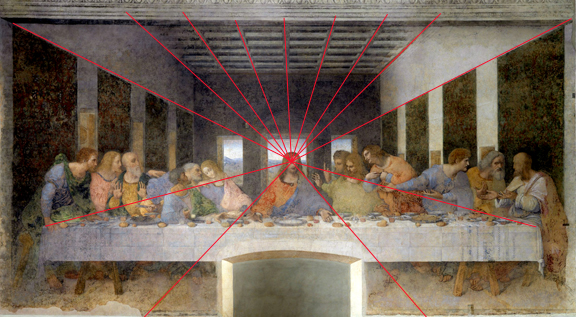
By drawing four more lines to incorporate features in the lower half of the painting, we can extend this radial pattern to span most of the painting’s circumference. Here we use the upper corners of the table top, as well as two diagonal lines that appear in the painting between the lower tablecloth and the bottom of the frame.

By doing so we have produced 12 lines which seem like obvious points of connection in the painting. Although we could continue drawing a few more lines at this point, perhaps it is worth taking a pause here and step back a bit for a moment.
To reflect on what it was that had prompted me to begin a search for Sacred Geometry on The Last Supper was somewhat multi-faceted to begin with. For awhile, I had been researching some ideas that came to light through the Maranatha puzzle book. Remembering now that on the reverse cover it was stated:
“This ‘Key’ was devised to unlock the
greatest treasure known to history.
To some that treasure is called ‘Nicolas Flamel’s Philosopher’s Stone’,
But to most it is called the
‘Holy Grail’
Nicolas Flamel Discovered it,
Leonardo da Vinci Encoded it…..”
I’ve thought long about what Leonardo might have ‘Encoded’, and how this related to the ‘greatest treasure known to history’. In the Timeline at the back of the book, there are several dates that connect historic events with the events described in the book. Of these events, in 1483 it states that:
“Leonardo da Vinci paints ‘The Virgin of the Rocks’, the specifically named painting which holds a message of the painter’s initiation to an understanding.”
But then for 1650 there is another event that is described in almost exactly the same way:
“Nicolas Poussin paints his second self-portrait, a painting that holds a message of the painter’s initiation to an understanding.”
Taking these two events into consideration, it dawned on me that the “message of the painter’s initiation to an understanding” could in fact be the tilted hexagram geometric “key” which followers of the Maranatha book and its ensuing saga should now be very familiar with. However, we have only seen the “Key” being demonstrated on Poussin’s “The Shepherds of Arcadia” and another painting made by Teniers, “St. Anthony and St. Paul in the Desert” so far.
Yet, it was also revealed through the “Time Monk Project” article on Andrew Gough’s former site ‘Arcadia’ that the same geometry demonstrated on the “Shepherds” painting could also be found in Poussin’s second portrait. Shortly after the article had come out, I made an attempt at reproducing this geometry on his painting. Here were the results:
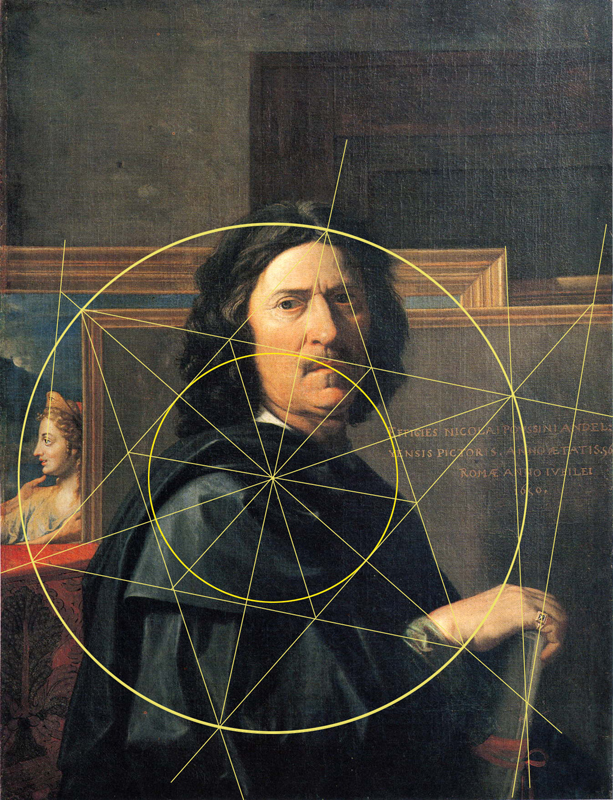
Thus, if the Poussin painting were to involve this geometry, and, if this were also meant to reveal his “initiation to an understanding”, then it followed reason to look for the same geometry in Da Vinci’s “Virgin of the Rocks”. I attempted this somewhat recently.
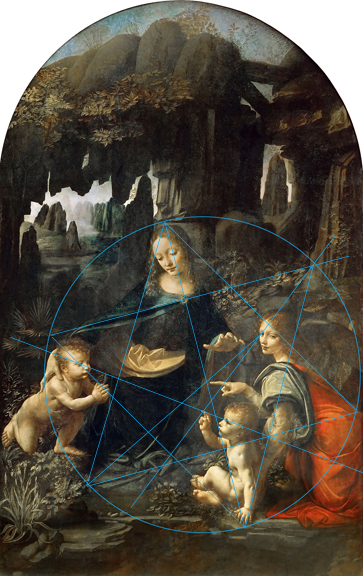
With these two paintings now “accounted” for (in terms of holding “a message of the painter’s initiation to an understanding” and what that might potentially mean) I then moved on to see if this could shed any light on other elements in the timeline. For the entry 1495, it states that:
“Leonardo paints the Last Supper and encrypts a message.”
So now, at this point, in addition to Leonardo’s “initiation to an understanding” (assuming it as the tilted hexagram key), we have this to consider as well; the possibility that he encrypted a message in The Last Supper. Take a moment if you will to compare the language found in the timeline with the language on the back cover of the book. In the timeline it states the he “encrypts a message”. On the back it states that “Flamel discovered it, Leonardo encoded it”. And what was it again that Leonardo encoded? Allegedly, the very thing in which the “Key” was devised to “unlock”. That being “the greatest treasure known to history”, the “Holy Grail”.
From this, we might conclude that what is being illuminated here is that the “Key” (the message of the artists’ initiation to an understanding) was devised to “unlock” the very thing which Leonardo encrypted –ie, had encoded– in The Last Supper.
Which brings us back to the vanishing point of Leonardo’s The Last Supper. While considering the relationship of the 12 apostles to the 12 signs of the Zodiac, it is rather simple to consider the first 12 lines drawn so far to establish the compositional vanishing point as being supportive of the same idea. This idea being that the Sun and the heavens are connected to the characters in the painting through such symbolism. There is, however, further cause through available evidence left by Leonardo to reevaluate this from another angle.
While investigating the oeuvre of Leonardo’s work, particularly when it comes to the subject of geometry and composition, it is impossible to overlook his contribution to Pacioli’s “De Divina Proportione” (On the Divine Proportion, first edition 1509). In this book, Pacioli describes how the Golden Ratio relates to architecture, visual perspective and geometry. Accompanying this book is a series of approximately 60 illustrations of regular, geometric solids drawn by Leonardo Da Vinci himself. The role of the Platonic geometric solids plays a central role in this work. As Pacioli states:
“…just as God confers Being to Heavenly Virtue, by another name called Fifth Essence, and by its mediation, to the other four simple bodies, that is, to the four elements earth, water, air and fire, and, through these, to every other thing in nature, so this our sacred proportion gives the formal being – according to the ancient Plato in his attributing to heaven the figure of the solid called dodecahedron , otherwise the solid of 12 pentagons, which, as will be shown below, is not possible to make without our proportion. “ (translation by Dr. Jonathan Tennenbaum, John P. Scialdone, Richard Sanders, “Luca Pacioli’s 1498 On the Divine Proportion”, 2005)
The five bodies referred to here by Pacioli are of course the five platonic regular solids: the tetrahedron, the hexadedron (cube), the octahedron, the icosahedron, and the dodecahedron mentioned above. Of worthy note is that fact that the dodecahedron has 12 faces, which is of course similar to number of lines drawn so far, as well as the number of the apostles. And, as Pacioli states above, the dodecahedron was equated by Plato with the heavens, which again confers with the idea of the 12 stations of the Zodiac and the existence of the celestial sphere.

Getting back to Leonardo’s Last Supper then, it occurred to me to look for the presence of a geometric solid as the means for the painting’s composition. Most specifically, the dodecahedron. Using the very same drawing that Leonardo drew for De Divina Proportione, the results were quite astonishing.
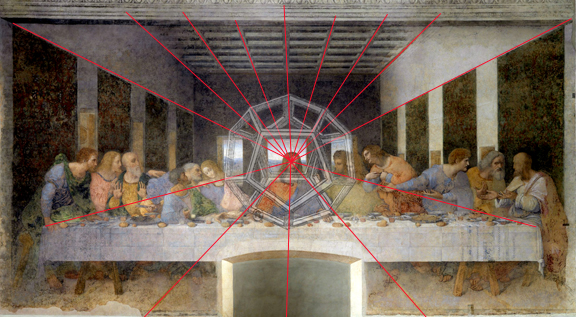
As one can see, the radial arms of the vanishing point confer with corners of the dodecahedron. The fact that the spacing of the lines in perspective match at exactly these points and at this ratio of division seemed quite convincing to me. All that was missing was the single line extending downward into the portal below.
What seemed to confirm this idea even further was that, upon closer inspection, the characters in the painting actually appear to be responding to the presence of the hidden shape.
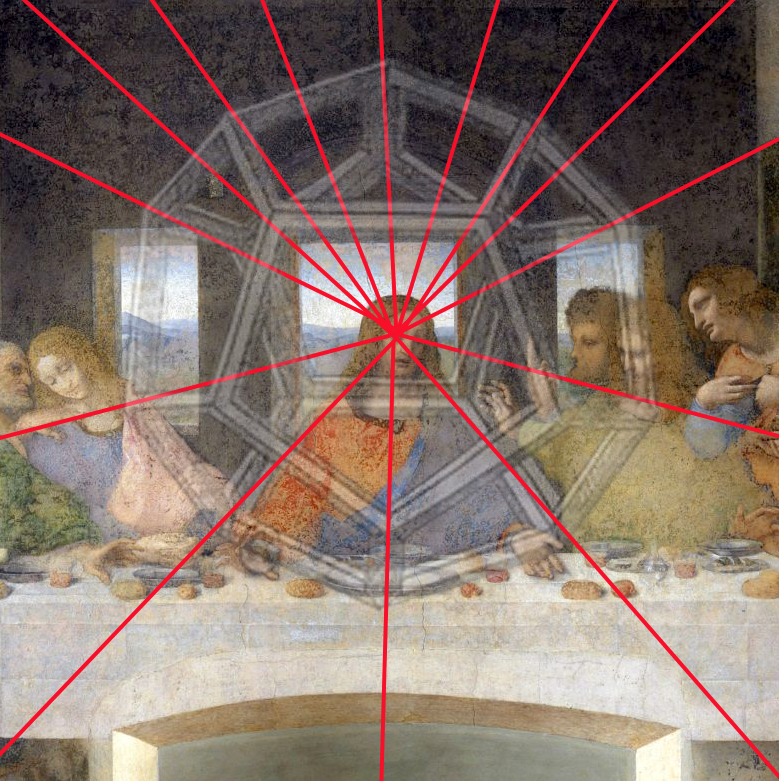
Two figures to the right of Christ, we see St. James the Great react and extend back with his arms open as if looking at the object. To the left of Christ we see the figure commonly identified as John leaning to the side, while one edge of the shape follows the line of his arm. The hand of Peter which is drawn across the neck of John marks the crossing of a line. The pointed finger of Thomas to the right even marks a point where an edge crosses over.
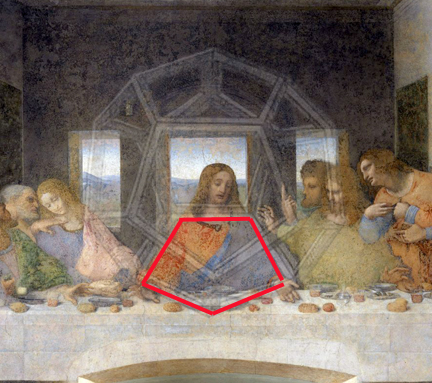
But furthermore, what seems to also acknowledge the shape is the outline of Christ’s shoulders, his palms and the center line beneath, creating a singular pentagonal face of the dodecahedron as we can see here. These clues all added up convince me that this sacred geometry was intentional.
In conclusion, it seems quite uncanny that the relationship between the corners of Leonardo’s drawing of a dodecahedron matched the radial vanishing point lines of this painting’s compositional perspective. So far, I have found one other researcher by the name of Sabrina Sforza Galitzia who agrees upon the possibility that Leonardo’s composition was based on this shape:
“Somewhat of a bone structure that God used to draw the universe according to the Greek philosopher, later portrayed by Raphael in the School of Athens’s fresco, personified by da Vinci that holds the book Timeus with his left hand while pointing to the sky with his right index finger. We learn from Pacioli himself that Leonardo for the perspective of the Last Supper mural used the dodecahedron built with the “holy” or divine proportion.” (ASTRONOMY & The secret perspective of Leonardo and Pacioli, 2006 by Sabrina Sforza Galitzia)
If such is the case, then we are left to assume that it is through this geometry, or at least by some extension of it, which we can devise what Leonardo had encoded, or encrypted, in the Last Supper. If this is in fact the “lock”, or by some means related to it, then the next step is only to discover the relationship between the key and the 3 dimensional geometry.
But are we meant to look at just the dodecahedron, or is there more to this picture? Before departing, perhaps we can take a cue from the work of Johannes Kepler:

“I propose to show that God, in creating the universe and arranging the spheres, had in view the five regular solids of geometry, and fixed by their dimensions the number, proportions and motions of the spheres.” (Mysterium Cosmographicum, 1596)
Kepler was well known to have developed the initial stages behind the idea that the platonic solids are significantly interrelated. As the picture above shows, the corners of one related to the vertices of another. If we are going to “turn the lock in the key” then perhaps THIS is the point which it transitions upon.
~ by MW Team Writer: Hayward Gladwin
Copyright 2017 by Hayward Gladwin. All Rights Reserved.

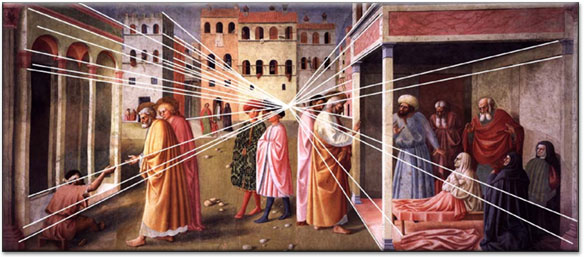
Excellent discovery and article, Hayward. The path you followed and then guided us on was truly an experience to be enjoyed. So much hidden and to be found! Thank you for sharing your amazing work with us.
A pleasure as always Jenny, many thanks!
Hayward, thank you for taking the time to write this an include the geometric interpretations. Made my morning to see it here at MW so near to Good Friday.
Have you heard of the hidden music? https://youtu.be/018pS-2q35I
23kachinas- Happy to oblige. The timing does seem uncanny!
Interesting theory re: hidden music. Not so convinced –yet– about what determines the placement of the music staff, but as Alessandro Vezzosi states, ” It is plausible”. Thanks for sharing.
Hi Nate- to my eyes, Poussin was very technical and observant with his work but Leonardo was just so very “lyrical” that it is almost visceral. So many layers, too which is how we probably end up with so many interpretations.
I feel very convinced by both.
QUOTE
“With regard to his use of perspective, Leonardo was successful in employing it to create an entension of the refectory and thus provides an illusionistic effect.
There have been discoveries of how Leonardo made use of this artistic measure. A hole into which a nail had been driven has been found, located in the temple of Jesus. The location is the key spatial focus of Leonardo’s painting of the Last Supper. He drove a nail into the wall and radiated string in various directions to help him see the perspective of the room he was painting.”
Perhaps a little bit higher than the right eye, if you look more closely at the image, there appears to be a little “dot” there. Interesting!
https://upload.wikimedia.org/wikipedia/commons/thumb/4/4b/Última_Cena_-_Da_Vinci_5.jpg/1200px-Última_Cena_-_Da_Vinci_5.jpg
This is curious as well:
Temple (anatomy)
Etymology
“Regarding the temporalis muscle: in English, this muscle’s name is the time muscle. The word temporalis comes from the Latin word tempus meaning “time.” The muscle covers the temporal bone, or time bone, which received its name because the hair of the head covering this bone is often the first hair to turn gray during the aging process. Therefore, this region is the first to show the effects of aging.[1]”
Mind racing, heart beating faster……..
@Nate- I think I get what you’re getting at, but I’m not sure. The way I’ve looked at the key, in the sense of creation, is related to a concept some others have referred to as “evolution” and “involution”. In the sense of evolution, we go from the circle (G_d), the triangle (G_d in the sense of the trinity, father/son/spirit -or- G_d/mother/father, etc., depending on your definition), then we get to the square (matter/earth/man/manifestation). In between these two “destinations”; G_d the circle and Man the square, we have the completion of the hexagram. The hexagram representing the “heavens”, the 6 classical planets (Mercury, Venus, Moon, Mars, Jupiter, Saturn) with the Sun (spiritual light) as the center point.
Thus, in terms of “involution” or “initiation” the process is essentially the reverse of G_d’s plan of creation. We start with the square and work through this order “inward” towards the circle.
Is this related to what you are talking about? Or is it more specific of a thing than that? It sounds like what you are talking about is more specific.
!!!!Well it seems I have the IDEA then but then not really what the “visual” is exactly which ties it together. Not interested in offending Masons whatsoever, but definitely interested in knowing what it is.
Does Lawlor actually portray the answer (which might easily be overlooked) or is more a “clue?”
The vanishing point is not in Christ´s face, but behind Him, in the Infinite where the sun rises, through the Door.
Christ´s shape forms an equilateral triangle, a Tetraktys.
The focal point is not – and cannot- be in the right eye, but in the infinity, through the Door of the primeval equinocce of Nisan, at the New Moon. The two windows at the solstice of Christ and of the Bautist.
No doubt, Il Cenacolo is a neoplatonic work, inspired in Ficino’s De amore, so he is portrayed en the first triad, arguing with Plato, about: Love.
The second triad means: Love is the desire of Beauty, perfectioned in God; and the next trio means: Do not return bad for bad (Plato, Criton).
Christ’s triangle is a Tetraktys, and into it there are other triangles,, for example a rectangular with the apex in the emerald. I suppose it is related to the circle’s quadrature.